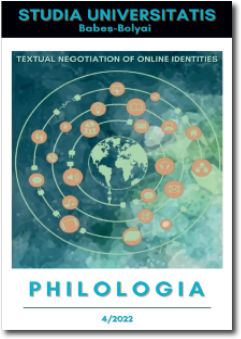MAPPING LANGUAGE LEARNING WITH EMOJIS: FROM PHATIC COMMUNICATION TO IDIOMS AND FLASH FICTION
DOI:
https://doi.org/10.24193/subbphilo.2022.4.14Keywords:
emojis, content creators, speech acts, multimodality, participatory cultureAbstract
Mapping Language Learning with Emojis: From Phatic Communication to Idioms and Flash Fiction. By roaming around digital resources in search of a customised learning approach, language learners often identify as netizens accustomed to a coded Internet language which is rarely juxtaposed with the language taught in the ESP classroom. To keep pace with shifting trends in online communication, teachers often need to expand the discursive membership by empowering learners to turn from users into content creators. By referring to the potential of using emojis in the framework of speech acts, the current paper aims to indicate directions of embedding emojis as social marking tokens and instruments of developing language and digital literacy skills in the foreign language class. The process of embedding emojis in language teaching stems from the integration of emoji as markers in the teaching of phatic communication, to reinforce the locutionary and illocutionary act of speech. Moreover, emojis can be used as an extension of teaching idioms, whereas the illocutionary and perlocutionary function of emoji is explored in interactive vocabulary practice tasks or within gamified sequences. Eventually, using emojis as perlocutionary acts in language learning is applied to storytelling as a mechanism of developing a multiliterate discourse, by means of which learners are introduced to writing emoji stories and flash fictions and then to translating them into words.
Article history: Received 31 July 2022; Revised 12 October 2022; Accepted 5 November 2022; Available online 20 December 2022; Available print 30 December 2022.
REZUMAT: Infuzarea învățării limbii cu emojiuri: de la funcția fatică la expresii frazeologice și ficțiune flash. Navigând printre resurse digitale în căutarea unei abordări personalizate de învățare, studenții se identifică adesea ca internauți familiarizați cu un limbaj codat al Internetului, care e rar corelat cu limbajul specializat învățat la cursurile de limbă străină. Pentru a ține ritmul cu noile tendințe din comunicarea virtuală, profesorii sunt deseori nevoiți să-și extindă apartenența la o tipologie discursivă prin încurajarea studenților să devină creatori de conținut. Analizând potențialul utilizării emojiurilor în cadrul actelor de vorbire, prezenta lucrare încearcă să indice variante de integrare a emojiurilor ca marcaje sociale și ca instrumente de dezvoltare a abilităților lingvistice și digitale în cadrul cursurilor de limbă străină. Procesul de utilizare a emojiurilor în predarea limbilor străine pornește de la integrarea emojiurilor ca indicatori în utilizarea funcției fatice a comunicării, pentru consolidarea actelor locuționare și ilocuționare ale limbajului. De asemenea, emojiurile pot fi utilizate în predarea expresiilor idiomatice, prin explorarea funcțiilor ilocuționare și perlocuționare în activități interactive de vocabular sau secvențe gamificate. Utilizarea emojiurilor ca funcții perlocuționare în învățarea limbii străine se aplică și scrierii narative, ca mecanism de dezvoltare a discursului de multiliterație, prin scrierea de narațiuni de tip flash fiction folosind emojiuri și apoi prin decodarea acestora în text.
Cuvinte-cheie: emojiuri, creatori de conținut, acte de vorbire, multimodalitate, cultură participativă
References
Ai, Wei, Xuan Lu, Xuanzhe Liu, Ning Wang, Gang Huang, and Qiaozhu Mei. 2017. “Untangling Emoji Popularity through Semantic Embeddings.” Paper Presented at the Eleventh International AAAI Conference on Web and Social Media. 11(1), 2-11. https://ojs.aaai.org/index.php/ICWSM/article/view/14903.
Aull, Bethany. 2019. “A Study of Phatic Emoji Use in WhatsApp Communication.” Internet Pragmatics. 2 (2): 206–232. https://doi.org.2.10.1075/ip.00029.aul.
Austin, John L. 1962. How to Do Things with Words. Oxford: Oxford University Press.
Bai, Qiyu, Qi Dan, Zhe Mu, and Maokun Yang. 2019. “A Systematic Review of Emoji: Current Research and Future Perspectives.” Frontiers in Psychology, 10: 2019. https://doi:10.3389/fpsyg.2019.02221.
Crystal, David. 2006. Language and the Internet (2nd ed). Cambridge: Cambridge University Press. https://doi.org.10.1017/CBO9780511487002.
Dresner, Eli, Susan Herring. 2010. “Functions of the Nonverbal in CMC: Emoticons and Illocutionary Force.” Communication Theory, 20(3): 249–268. https://doi.org/10.1111/J.1468-2885.2010.01362.X
Gee, James Paul. 2017. “Affinity Spaces and 21st Century Learning.” Educational Technology, 57(2): 27–31. http://www.jstor.org/stable/44430520.
Jenkins, Henry, Katie Clinton, Ravi Purushotma, Alice Robison, and Margaret Weigel. 2006. Confronting the Challenges of Participatory Culture: Media Education For the 21st Century. Chicago: The MacArthur Foundation. https://www.macfound.org/media/article_pdfs/jenkins_white_paper.pdf.
Li, Dan. 2019. “Examining the Functionality and Aesthetics of Emojis.” International Journal of Arts Education. 17 (1): 1-17. https://www.academia.edu/49144598/Examining_the_functionality_and_aesthetics_of_emojis.
Mudure-Iacob, Ioana. 2022. “From Emojis to Storytelling - Enhancing Language Learning Through Collaborative Approaches.” In Education, Reflection, Development - ERD 2021, vol 2. European Proceedings of Educational Sciences edited by Ion Albulescu and Cristian Stan: 642-658. European Publisher. https://doi.org/10.15405/epes.22032.64
Paivio, Allan. 1971. Imagery and Verbal Processes. New York: Holt Rinehart and Winston, Inc.
Rodrigues, David et al. 2018. “Lisbon Emoji and Emoticon database (LEED): Norms for emoji and emoticons in seven evaluative dimensions.” Behaviour Research Methods 50: 392-405, https://doi.org/10.3758/s13428-017-0878-6
Searle, John. 1969. Speech Acts: An Essay in the Philosophy of Language. Cambridge: Cambridge University Press. https://doi.org. 10.1017/CBO9781139173438
Yus, Francisco. 2019. Emoji: A Full Cyberpragmatic Approach. Paper Delivered at the 16th China Pragmatics Conference. Nanchang (China). https://www.academia.edu/48934618/Emoji_A_full_cyberpragmatic_approach
Zhou, Rui, Jasmine Hentschel, and Neha Kumar. 2017. “Goodbye Text, Hello Emoji: Mobile Communication on WeChat in China.” Proceedings of the 2017 CHI Conference on Human Factors in Computing Systems: 748-759. https://doi.org.10.1145/3025453.3025800
Webography:
https://view.genial.ly/62e24c8b8e85840011d75eb7/interactive-content-emoji
https://jamboard.google.com/d/1LrnuUDZEZrgZ5dpib4jWrVnLIH6zxusf-EEH2xetw6E/edit?usp=sharing
Downloads
Published
How to Cite
Issue
Section
License
Copyright (c) 2022 Studia Universitatis Babeș-Bolyai Philologia

This work is licensed under a Creative Commons Attribution-NonCommercial-NoDerivatives 4.0 International License.





 ©Studia Universitatis Babeş-Bolyai Philologia. Published by Babeș-Bolyai University.
©Studia Universitatis Babeş-Bolyai Philologia. Published by Babeș-Bolyai University.